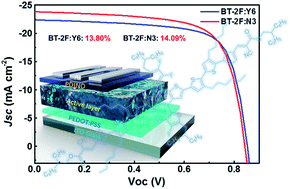Over 14% efficiency nonfullerene all-small-molecule organic solar cells enabled by improving the ordering of molecular donors via side-chain engineering†
Abstract
Improving the short-circuit current density (Jsc) is a big challenge for gaining highly efficient nonfullerene all-small-molecule organic solar cells (NFASM-OSCs). Herein, a novel small molecular donor, BT-2F which is derived from previously reported BTEC-2F, was designed and synthesized. The shortened alkyl-chains with higher regularity endow BT-2F with more ordered packing arrangement and more compact lamellar stacking as evidenced by the characterization of differential scanning calorimetry and grazing incidence X-ray diffraction. By blending BT-2F with Y6 or N3, BT-2F based devices showed impressive power conversion efficiencies (PCEs) of 13.80% and 14.09% respectively, much higher than the reported PCE of 13.34% for BTEC-2F:Y6. Besides, the efficiency of 14.09% is also among the highest PCE values reported so far for NFASM-OSCs. The distinctly improved Jsc resulted in enhanced PCE values, meanwhile both BT-2F:Y6 and BT-2F:N3 still maintain high fill factors of over 70%, which are ascribed to the good balance between high crystallinity and appropriate phase separation.



 Please wait while we load your content...
Please wait while we load your content...